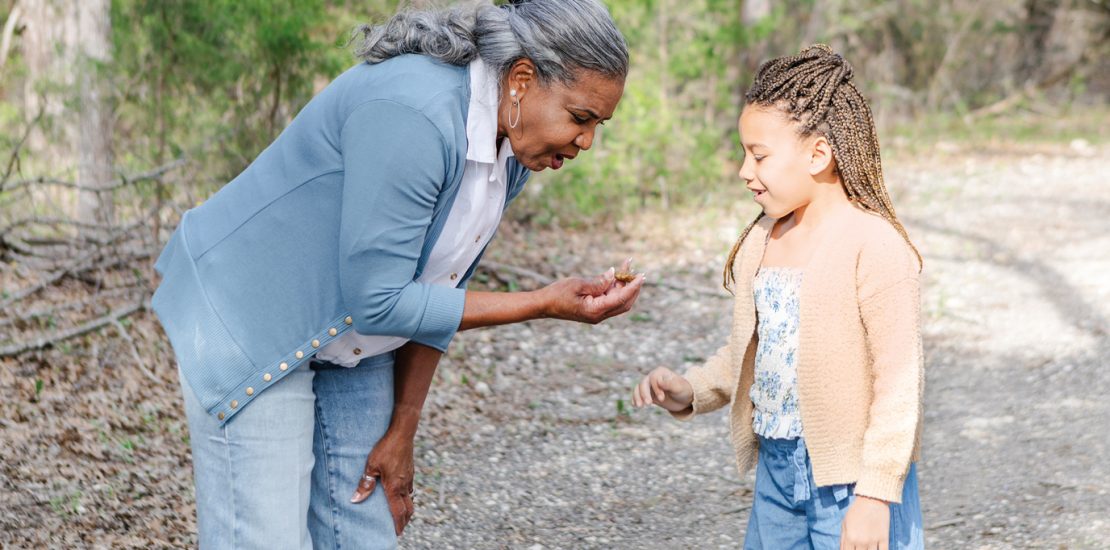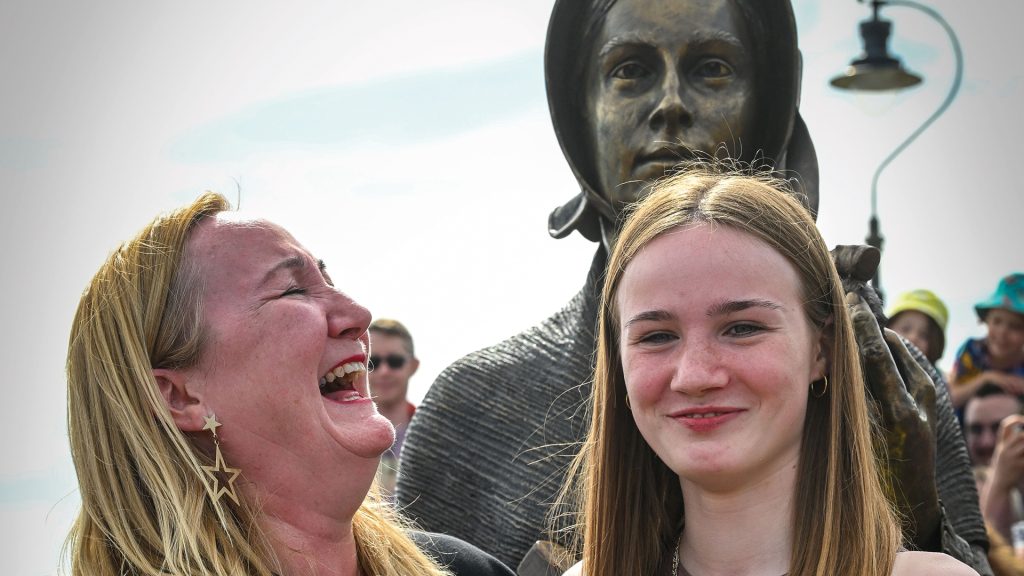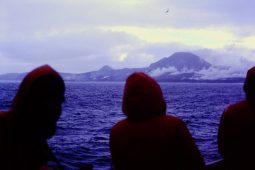A forgotten generation of influencers
Women of a certain age could be key to reviving interest in geoscience, reasons Anjana Khatwa

Enjoying a nature hike together, a grandmother leans in to show her granddaughter something she found on their path. © Getty
A negative bias surrounds women in their midlife – highlighted recently when a well-known TV presenter used the phrase ‘women of a certain age’ to dismiss those critical of his behaviour. Yet many of these determined, informed women play major roles in their grandchildren’s lives and are the real influencers with whom geoscientists should be working on public engagement.
Enduring interest
Many of the midlife women I have met through my work with Girlguiding Southwest England and whilst lecturing on cruise ships have told me how their passion for science at a young age was squashed by a misogynistic careers advisor or through being pushed into jobs apparently more suited to their gender, such as nursing or secretarial work. A Girlguiding unit leader was left in tears after one of my talks. Encouraged into the field of geoscience by her father (a Cornish quarryman), she was refused any work in the industry. Now in her late sixties, she saw my career as one she could have had. As she clutched my hands with tears streaming down her cheeks, she exclaimed how proud she was of me – that I represented the person she could have been had she not been so callously turned away from a profession she would have excelled in.
Despite such setbacks, these women’s interest in science endures. For example, I have been struck by the hundreds of women who engage with my posts on a Facebook group associated with a UK beauty brand that has a vast global following of over 100,000 women, mainly over the age of 45. Although some are retired from STEM occupations, the majority are non-scientists hungry for knowledge – knowledge that not only helps enrich their own lives but also those of the grandchildren they care for.
In their 2011 report, Doing it All, care charity Kinship reported that two thirds of grandparents (aged 54 to 74 with grandchildren under 16) say they look after grandchildren. Of these caregivers, grandmothers are more likely to provide higher levels of childcare than grandfathers, offering at least 10 hours of childcare a week (with younger, working-age grandmothers aged 50 to 65 often providing 35 hours or more of childcare per week). My experiences have shown that this generation of women, especially those who have had barriers and disappointments in their professional lives, are invested in ensuring their grandchildren are supported and inspired to achieve what they could not.
Here lies a golden opportunity for practitioners in public engagement to enrich the lives of midlife women eager for knowledge and self-development
To date, public engagement in the geosciences has mainly focused on inspiring and supporting children and young people in formal education settings. But how is this enthusiasm nurtured and encouraged once they leave the classroom? Some older children will seek engagement in the digital space with social media geo-influencers, but what about those unable to access digital resources, or those children in early years and primary education? Here lies a golden opportunity for practitioners in public engagement to not only enrich the lives of midlife women eager for knowledge and self-development, but to support them in their quest to raise a generation of children and young people connected to the world around them.
Engagement programmes
During my role as Engagement Lead at Wessex Museums, we prioritised programming for the under-fives, regularly attracting grandparents who thrived in this socially engaged atmosphere. Museums with natural history collections can specifically design early years programming tailored for grandparents that not only satisfies intellectual curiosity about the geosciences but also provides activities for children to bond and learn with their carer.
For organisations managing natural landscapes, working equitably alongside community groups can generate ideas and outcomes for grandparents who need additional support to provide activities for the children they care for. Guided, accessible walks in nature can not only improve mental health and wellbeing for the carer and their grandchild but also reduce loneliness and enhance confidence to enjoy the outdoors. A vital part of developing any engagement programme is to work closely with the community to ensure that content and experiences are co-created in a meaningful and considered way.
For midlife women who are seeking interaction with fellow curious (adult) minds, organisations could look towards setting up socials that focus on enriching conversations, non-fiction book clubs and lectures that centre the voices of women who reflect them at their stage of life.

Evie Swire and her mother Anya Pearson stand in front of a statue of Mary Anning, on May 21, 2022, in Lyme Regis, England. The life-size bronze statue of fossil hunter Mary Anning was made possible by a fundraising campaign led by local schoolgirl Evie and her mother, who realised that the resort had no statue to mark her history. More than £100,000 was raised by the charity Mary Anning Rocks to pay for the statue. The film “Ammonite”, loosely based on the story of the paleontologist and played by Kate Winslet, was released in 2020. © Finnbarr Webster/Getty
Women rising
Despite facing social exclusion and marginalisation (alongside navigating complex health issues such as the menopause), women in later stages of life are not dwelling on this deficit model. Rather, thousands of women are expressing their power, influence and social positioning. For example, in March 2025, new UK festival Forthwrite was launched, celebrating writing by those who identify as women over the age of 50. Also, Mary Anning Rocks, the charity that raised over £150,000 to erect a statue of Mary Anning in Lyme Regis, was led by Anya Pearson, a passionate advocate who continues to champion recognition for historical midlife women through the Visible Women UK campaign. These movements send a key signal to society – women of a certain age are rising.
As these voices grow stronger, I wonder if the key to addressing the declining interest in geosciences and the persistent gender (and pay) gap rests in the hands of midlife and older women? Fewer than 40% of places on undergraduate geoscience courses in the UK are taken up by girls and less than half of this figure then continue into the UK STEM workforce (Fisher & Boulton, 2020). As I reflect upon my own successful career, including my debut non-fiction book being released in my 50th year, I was very much enabled and supported by women of a certain age. From my mother to my geography teacher, and then from my PhD supervisor through to the women who surround me today – all have played a part in raising me to be the person I am now.
Women of a certain age are actively changing and influencing society. From raising children to erecting iconic statues, from writing books to rewriting history, they are using their wisdom, experience and tenacity to steer our society towards a more equitable and empathetic future. We ignore them at our peril.
Dr Anjana Khatwa
Earth scientist, EDI consultant, presenter and author
Further reading
Wellard, S. (2011) Doing it all? Grandparents, childcare and employment: An analysis of British Social Attitudes Survey Data from 1998 and 2009. Grandparents Plus. Kinship Report; kinship.org.uk/wp-content/uploads/2024/09/Doing-it-all-2011-report.pdf
Fisher, J. & Boulton, S. (2020) Girls into Geoscience: inspiring the next generation of female Earth Scientists, EGU General Assembly 2020.
Citation: Khatwa, A. A forgotten generation of influencers. Geoscientist 35 (3), 16-17, 2025. DOI: 10.1144/geosci2025-019.










